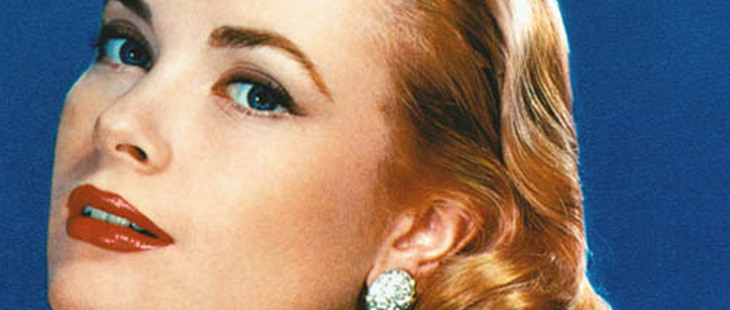
How many women are you allowed to be? Here lies perfection in the form of one Grace Kelly, enshrined at the TIFF Bell Lightbox, as she has been at the Victoria & Albert in London, and as she’s been in the cultural unconsciousness for decades now. Nobody will be more perfect than Grace Kelly, now that we have HD, not even January Jones on Mad Men. This is an exhibit dedicated to the great looker Kelly; the last exhibit at the TIFF Bell Lightbox was about great director Fellini; the one before that was for great director Tim Burton. Males are auteurs. Women are actresses (not actors) and style icons and beauties. So it goes. “From Movie Star to Princess,” the exhibit is subtitled. Wow. What a stretch. That must have been a difficult transition for you, Grace Kelly. Tell me more about that transformative process. How exactly did you go from wearing Oleg Cassini to Hubert de Givenchy? From mere diamond brooches to tiaras? From being worshipped by many to being worshipped by many more? From the king of mid-century film to the Prince of Monaco? I mean, was it hard to go from mere adoration to total forever goddess-worship? And did you ever feel like you weren’t blonde enough? To be honest, give me a break. Still, to TIFF’s credit, they try to play it like Ms. Kelly was a brilliant actress instead of merely a beautiful woman with beautiful expressions and perfect diction and style who could charm any director, even Hitchcock, into thinking she was not only something, but everything, even though she was no better an actress than Novak, or like, Monroe. The exhibit is small, succinct, expensive, well-done, overwhelmingly unrevelatory. That there is an exact replica of Kelly’s wedding dress, apparently looking more real than the real thing, might say it all. One day last week I recorded audio tracks, which you can hear if you go to the selfsame exhibit and put on a pair of headphones and listen. I don’t know what I’m saying. I think I compared Grace Kelly to Mary-Kate Olsen, hiding her (real???) self behind those oversized sunglasses and that oversized Hermes bag. Mary-Kate’s was Balenciaga, though. Grace’s Hermes is now called the “Kelly,” and no one will beat it for pure classic bullshit iconicism, no Olsen, nobody. Guiding us through the expo, TIFF Artistic Director Noah Cowan stopped, gestured to the bag, and said something like, oooh, I bet the women know this one. I looked at the floor. Too late; one woman was actually clapping her hands. The “Kelly:” it’s really famous, it costs thousands of dollars, there’s a waitlist, and they wait. Women. I wanted Noah Cowan to be wrong so badly with his “all the ladies in the audience, clap your hands”-type expression, but he was right. We still want our princesses. It is not just that we have exhibits dedicated to Grace Kelly and her one great talent, beauty. (Okay, fine. She could also dress herself, and dress herself exceedingly well.) That makes sense: very very few women could have been auteurs, then, even if they pleaded to be. There’s a sad little coda to the Kelly thing, which you can see at the exhibit’s exit, if you bother to stop: near the end of her life she made a film in which she plays herself, essentially, convincing a mad-with-love scientist that flower-arranging (Kelly’s main personal hobby) is worthwhile. I wish I were making that up. But it’s not just that. It’s that we have Kate Middleton, and we have Kim Kardashian, both of whom had massive economy-deaf recent weddings that took place in different worlds (America, England), and for different reasons (well, maybe not so different; capitalism), and one of whose marriages can end (and has), and one of which can’t (and might still), and that these are the women who have been inescapable, news-wise, this year. The new K’s, the new Kellies. They’re not doing anything, and almost nobody thinks they are; these weddings are the mid-century throwback pinnacles of their total non-careers. But they are each, in their own way, perfect: smiling always, waving to everyone, the peoples’ princesses. And we are more than happy-ever-after to make them so, to make them the receptacles, the projections, of our fantasies. Men will take care of the real news. When we are tired of news–and the men making it–there will be women. There will be princesses, there to entertain, to make real the day’s reigning ideal, to make the rest of us aware of what we’re not. Nobody asks a man to embody perfection, not even if he is Ryan Gosling. Gosling is (as the Drive soundtrack endlessly intones) a real hero. Only women movie stars, and princesses, are forced to be ideals. Last week, the 16 countries that still recognize the British monarch as head of state–including ours–struck what even the New York Times called “a historic blow for womens’ rights” by abolishing the rule of male succession. To wit, if the Duchess of Cambridge (nee Middleton) gives birth, and that first child is a girl, the girl will be queen. Even if she has a younger brother, she’ll be queen. I don’t personally care whether a powerless princess can become a powerless queen, but maybe the symbolism will resonate with all the half-grown girls who love–let’s say–Nicki Minaj, who is sorta secretly the baddest bitch in the mainstream hip-hop game but still, for the sake of success, flounces around in pink pink pink pink pink and doesn’t know whether or not to be ironic about it and talks sometimes in a posh-London accent and just posed for W as, quote, a “rococo princess.” Or Selena Gomez, the “pop princess” who was in a movie with a similar name, and poses for magazines as fairy-tale heroines in a way no boy would be made to do. Or Taylor Swift, who made a song called “I’m Not a Princess,” but also songs called “Love Story,” “Enchanted,” and “White Horse.” Or Anne Hathaway, who built her whole Oscar-baiting career on succumbing to princesshood. Or all of our socialites, our still-clinging party rulers, those contemporary blonde-dyed it-bag-carrying do-gooding diamond-y types who never, ever look like they like sex. And even our Toddlers are in Tiaras. We love–still!–these princesses as ideal females because there are no two ways about them. If you’re a princess, you’re beautiful, and you wear beautiful dresses. You’re good, and you do good things. If you want to not be good, as Diana wanted to not be good, that’s fine. You just (cue divorce) can’t be a princess any more. We have Harry, with his escapades and his scads of women and his underwear model-girlfriend, but there are still no princess-whores. Grace Kelly: From Movie Star to Princess runs from November 4 to January 22, 2012, at the TIFF Bell Lightbox. __ Sarah Nicole Prickett is the Toronto Standard Style Critic.














